Chicago Spire
The Chicago Spire was a skyscraper project in Chicago that was partially built between 2007 and 2008 before being cancelled. Located at 400 N. Lake Shore Drive, it would have stood 2,000 feet (610 m) high with 150 floors and been the tallest building in the Western Hemisphere. When originally proposed as the Fordham Spire in July 2005, the design had 116 stories, included a hotel and condominiums, and was topped with a broadcast antenna mast.[6] The building was designed and spearheaded by Spanish architect-engineer Santiago Calatrava and Chicago developer Christopher T. Carley of the Fordham Company. On March 16, 2006, the Chicago Plan Commission unanimously approved the initial design of the building.[7] On November 4, 2016, a court ruling brought the original development plan and the extended litigation over the nine-year-old project to a close.[8] Developer Garrett Kelleher signed over the property location to the project's biggest creditor, Related Midwest, who announced that they would not build the Spire and released plans for a different project.[8]
| Chicago Spire | |
|---|---|
 Artist's impression of the megatall Chicago Spire | |
| General information | |
| Status | Abandoned |
| Type | Residential[1] |
| Location | Lake Shore Drive Chicago, Illinois, United States |
| Coordinates | 41°53′23.6″N 87°36′53.6″W |
| Construction started | June 25, 2007 |
| Completed | Abandoned |
| Opening | Abandoned |
| Height | |
| Tip | 2,000 ft (610 m) |
| Roof | 2,000 ft (610 m)[1][2] |
| Top floor | 1,865 ft (568 m) |
| Technical details | |
| Floor count | 150[3] |
| Floor area | 3,000,000 square feet (278,700 m2)[4] |
| Design and construction | |
| Architect(s) | Santiago Calatrava Perkins and Will |
| Developer | Shelbourne Development Group[5] |
| Structural engineer | Thornton Tomasetti |
| Main contractor | Case Foundation[5] |
Planning
.jpg.webp)
Christopher T. Carley of the Fordham Company proposed the Fordham Spire in July 2005. In the proposal the Spire was to be a 116-story structure with hotel and condominiums topped by a tall broadcast antenna mast.[6] The initial design of the building was passed unanimously by the Chicago Plan Commission on March 16, 2006, and by the Chicago Zoning Committee on March 23, 2006.[7] On March 29, 2006, the Chicago City Council also approved the building's design.[9] As part of the approval process, the council passed a measure that raised the height limit on structures at the site to accommodate the 2,000-foot (610 m) design height. The Fordham Spire would have become the second tallest building in the entire world, surpassed only by the Burj Khalifa, and would have become the tallest freestanding structure as well as the tallest building in the Western Hemisphere, surpassing the CN Tower in Toronto.[10][11][12]
The building was designed by Spanish architect Santiago Calatrava and was being developed by Garrett Kelleher of Shelbourne Development Group, Inc., the then-owner of St Patrick's Athletic F.C.[1][2][13]
Chicago Mayor Daley said he approved of the design, stating that it was environmentally friendly. Burton F. Natarus, who was the 42nd-ward alderman when the building was announced, said, "This is a very unique opportunity for the city of Chicago. This building belongs to Chicago and should be in Chicago."[14] Donald Trump immediately voiced opposition to the building, stating that the tall structure would be a target for terrorists and did not even seem to be a viable project.[15]
.jpg.webp)
Development
Initial financial problems
After several months of development in 2005, Carley failed to obtain sufficient financing for the construction of the building.[16] Irish developer Garrett Kelleher, executive chairman of Shelbourne Development Group, Inc., acquired the land and took over the project. It was announced that he would put up 100% of the equity, something Carley had been unable to do.[16][17] He also had the financial backing to acquire the land, something Carley lacked. Kelleher stated he would consider using Carley's services on the development and that "Carley will be paid an unspecified sum for his involvement in the deal so far."[18] Kelleher later renamed the project "Chicago Spire" after briefly going by "400 North Lake Shore Drive", as it was no longer a Fordham project.[18]
New designs
In the final quarter of 2006, Shelbourne Development issued two separate press releases regarding the construction and design of the spire. A November 2006 press release stated that construction of the Chicago Spire would begin in June 2007. In early December 2006, Shelbourne Development issued another press release stating that the design of the building had been revised. This included the removal of the hotel and the antenna mast, making the building consist solely of condominium units. The design change altered the building design such that it was wider than the original plan. Additionally, the spire no longer tapered at the top, resulting in an increase in floor space and overall floor count. The revision also removed the separate parking structure from the original plan, instead incorporating underground parking into the spire itself.[1] This first major redesign of the Chicago Spire was criticized by architectural critics and city officials.[19]
In late December 2006, the Chicago Tribune reported that the developer was soliciting opinions on a further revision from community leaders.[20] Several weeks following that report the Chicago Tribune held an exclusive interview with architect Santiago Calatrava and lead developer Garrett Kelleher. During the interview, Calatrava drew out design ideas restoring the rotating design of the building and showcasing his vision for the Chicago Spire's lobby.[21] On March 26, 2007, further revisions were shown during a public presentation by Shelbourne Development showcasing the most recent design.[22]
Approval
Following the March 26, 2007 public presentation by Shelbourne Development, residents showed a favorable reaction to the newest design of the Chicago Spire.[23] The Chicago Plan Commission approved the final plans of the Chicago Spire on April 19, 2007.[23][24][25] Chicago's zoning committee also approved the tower on April 26 and, on May 9, 2007, the Chicago City Council approved the final design of the Chicago Spire.[13][24]
Marketing
By June 2008, Shelbourne had sold more than 350 of the 1,193 units—more than half of those to foreign investors in markets where certain United States Securities and Exchange Commission regulations do not apply. Shelbourne announced on September 30, 2008 that the building's penthouse had been sold to Beanie Babies manufacturer Ty Warner.[26] Kelleher offered to rent out units at a guaranteed 7.5% return to spur sales. The approach is common outside the United States where the tower was marketed more heavily and was meant to spur sales of the smallest units, which are the most likely to be purchased as rental property investments by foreigners.[27]
Financial crisis and suspension of construction

By October 2008, the late-2000s recession was beginning to affect the project. Construction was suspended and the tower's architect, Santiago Calatrava, placed an $11.34 million lien on the construction site, stating that Kelleher had not yet paid him for his work.[28] Within a few months Anglo Irish Bank, the primary lender for the project, was on the brink of financial collapse.[29] The bank's stocks had lost nearly all of their value and Anglo Irish Bank was facing nationalization.[29] Due to the bank's dire financial situation, Shelbourne Development was forced to suspend construction,[30] and would eventually have to pay back the $69.5 million (USD) it had already borrowed.[29][31]
Additional litigation and liens threatened the project by autumn 2009. The owner of the NBC Tower in Chicago sued to evict Shelbourne Development from their sales office, where extensive modeling of Chicago Spire units had been installed.[32] The lawsuit alleged that Shelbourne was behind $316,000 (USD) in lease payments.[32] In addition to this and other liens listed on the property,[33] Bank of America filed a lawsuit against Shelbourne Development for $4.92 million (USD).[34] The lawsuit was an attempt to collect that sum on two unpaid loans used for initial construction at the Chicago Spire site.[34]
After these setbacks, the AFL–CIO and Kelleher announced in late 2009 that they were discussing the potential for a $170 million (USD) land loan that would retire Kelleher's loan from Anglo Irish Bank, pay off the outstanding liens, and restart work in exchange for making the construction a complete union job.[33] Due to the lack of construction and the sluggish economy, Chicago unions were desperate to find work for their employees as they faced near 30% unemployment.[31] Construction of the Chicago Spire would have provided approximately 900 full-time jobs to union members for four years if construction had resumed.[31] In addition to the $194 million (USD) that Kelleher has invested personally in the project already, backup financing of an unspecified amount and from an unknown source in the form of mezzanine capital and bridge loans has been guaranteed and would have kicked in automatically if the $170 million (USD) AFL-CIO loan had been secured.[35]
But within weeks of the official announcement that Kelleher was searching for union bailouts, four major labor union investment funds declined to offer Shelbourne Development any loans.[36] Kelleher continued to search for financing.[36] Shelbourne Development faced eviction from its offices on the 50th floor of 111 South Wacker Drive on which Shelbourne owed $27,600 in unpaid rent.[37] Earlier in the year, the spire's Chicago sales office had been ejected from the nearby NBC Tower.[38]
In October 2010 Anglo Irish Bank Corp. filed a $77 million foreclosure lawsuit against Kelleher, claiming that loans made to Kelleher's development company had been in default for a year. The bank was expected to take possession of the site.[39] By the end of the year, courts handed control of the site to a receiver, leaving the project (at the time) dead.[40][41] In addition, two Chicago firms purchased the tax lien certificates on the property.[42]
End of the project
In 2013, with the Chicago Spire site for sale by Ireland's National Asset Management Agency (NAMA),[43] interest resumed, drawing in at least a half-dozen offers for the property. Under the involuntary bankruptcy ruling in October 2013, Shelbourne had until the end of March 2014 to obtain approval of a reorganization plan, and was considering a bid to take back control of the property, reigniting hope that the skyscraper might actually be built.[44]
In February 2016, Shelbourne sought court approval to take up an offer of up to $135 million from Atlas Apartment Holdings intended to underpin the project's emergence from bankruptcy, with a deadline of August 31, 2016 for having a court-approved reorganization plan.[45][46] At a hearing on March 11, 2016, Shelbourne announced that it had reached agreement on a repayment plan with the project's creditors, including Related Midwest, which had bought up much of the project's debt. Assuming the project finds funding to satisfy that agreement, Atlas said that the building would be built and that Atlas would control the project, but that Kelleher would still be the developer, with the intention of building the same building planned prior to the suspension of construction.[47]
However, on October 31, 2014, the developer failed to make a required payment to Related Midwest and Related filed suit to compel Shelbourne to turn over the deed to the property.[48] On 4 November 2016, Garrett Kelleher signed over the property located at 400 N. Lake Shore Drive to Related Midwest. President Curt Bailey said that Related Midwest would not build the Spire.[8]
In early 2018, the former developer Garrett Kelleher launched a $1.2 billion (USD) lawsuit, in the US Federal District Court in Illinois, against NAMA alleging that the agency destroyed his chances of building the Chicago Spire through a combination of "sheer spite" and "consistent incompetence". The lawsuit is formally brought by Kelleher's company, Shelbourne North Water Street Corporation.[49]
Future site development

In 2016, Crain's Chicago Business reported that Related Midwest had hired former SOM architect Michael Pfeffer to guide the design of developments on the former Chicago Spire site. Although President Curt Bailey disclosed no project details—such as whether, for example, Related Midwest plans to build one big tower or multiple structures on the site—he did announce the development firm's intent to discuss plan outlines with the public in 2017.[50]
In 2018, it was revealed that Related Midwest will build two skyscrapers at the site of the Spire. The taller of the two would include 300 condominiums and a 175-room luxury hotel and the other 550 apartments.[51] The two tower plan has been approved by the city and the development will be called 400 Lake Shore Drive.[52]
Location
The skyscraper was being constructed at 400 N. Lake Shore Drive, on Chicago's waterfront west of Navy Pier and northeast of the Loop, in the Streeterville neighborhood of the Near North Side community area. The site is at the junction of Lake Michigan and the Chicago River, and is bordered by the Ogden Slip of the Chicago River to the north, North Lake Shore Drive to the east, the Chicago River to the south, and existing residential property to the west. The site was originally zoned for two 35 to 50-story buildings.[11] Originally, it was to be sold by a joint venture of LR Development Company of Chicago and JER Partners of Virginia for $64 million to Christopher Carley of the Fordham Company.[53] After numerous short-term extensions, and later Carley's failure to obtain financing, Kelleher of Shelbourne Development purchased the land instead and pledged to finance the rest of the project.[16]
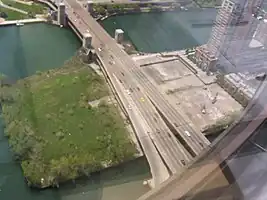
DuSable Park
When the project was first announced, the Fordham Company pledged almost $500,000 to assist in the development of the city's proposed DuSable Park, which would adjoin the property of the Chicago Spire.[54] DuSable Park would cover 3.24 acres (1.31 ha) and a $11.4 million budget was planned for its renovation.[55] On March 26, 2007, Shelbourne pledged to pay $6 million toward the development of the park, making up the deficit left over from the city's own initial pledge of $6 million and far exceeding the Fordham Co's initial offer.[56] In May 2007 Shelbourne's pledge jumped to $9.6 million.[57] Soil tests performed in December 2000 on the soil of the proposed park showed contamination of radioactive thorium.[58] Thorium was used by the Lindsay Light Company, which operated a location nearby. After the closing of the location in the 1930s, contaminated soil was dumped on the location of the proposed park. In March 2003, the Chicago Park District stated that the thorium clean-up on that land was incomplete.[59] Hazards of contamination can be avoided by laying a minimum of 6 inches (15 cm) of concrete over any affected soil, an approach that would be more feasible for the site of the Chicago Spire than for the adjacent park.[58]
In 2012 the Chicago Park District received funding from the EPA for remediation of the site, bagging the radioactive soil and shipping it to a Superfund site.[60] By summer 2013 the Park District website reported the remediation had been completed by September 2012.[61]
Architecture

As with many of his designs, Calatrava was inspired by themes and designs in nature for the tall, twisting skyscraper.[62] He likened the structure to an imaginary smoke spiral coming from a campfire near the Chicago River lit by Native Americans indigenous to the area,[63] and also related the building's newly designed pinnacle to the "graceful" and "rotating forms" of a snail shell.[21]
Standing at 2,000 feet (610 m), the Chicago Spire would have further transformed the always-growing Chicago skyline.[1][2][64] Plans for the tower included 1,193 condominiums with each of the building's 150 stories rotated 2.4 degrees from the one below it for a total 360-degree rotation.[65] In February 2008, prices for the condominiums were announced as ranging from $750,000 to US$40 million.[66] For supplemental structural support, each floor was to be surrounded by cantilevered corners and four concave sides.[67] Similar to the Willis Tower (formerly Sears Tower) and John Hancock Center observation decks, the Chicago Spire design included a community room on the top floor offering residents a view of four U.S. states.[68][69][70] The design for the soaring four story lobby of the skyscraper included translucent glass walls framed by arching, steel-reinforced concrete vaults.[21] The building has been described as a giant "drill bit" by the public and others in the media have likened it to a "tall twisting tree" and a "blade of grass".[19][71]
The curved design offered two major benefits to the structure of the building. First, curved designs, such as that found in Calatrava's Turning Torso in Malmö, Sweden, tend to add to the strength of a structure.[72] A similar principle has been used in the past with curved stadium roofs. In addition to structural support, the curved face of the exterior would minimize wind forces. In rectangular buildings, a fluid wind flow puts pressure on the windward face of the building; while air moves around it, a suction is applied to the leeward face. This often causes a sway in tall buildings usually counteracted, at least partially, by stiffening the structure or by using a dynamic wind damper.[72] Since the curved design of the Chicago Spire would not completely negate wind forces, a tapering concrete core and twelve shear walls radiating from it were planned to counteract the remaining wind load.[67]
Additionally, the Chicago Spire was designed with world-class sustainable engineering practices to meet Leadership in Energy and Environmental Design Gold recognition. Sustainable features included recycled rainwater, river water used for cooling, ornithologically-sensitive glass to protect migratory birds, intelligent building and management systems, waste storage and recycling management, and monitored outdoor air delivery.[65]
Construction
Following the city approval, it was announced that construction of the Chicago Spire was to begin in the summer of 2007, with caisson work scheduled to begin as early as June 2007.[73] DuSable Park was designated as a staging area for the construction of the tower.[74] The sales center for the Chicago Spire opened on January 14, 2008.[75]
On September 19, 2008, a spokeswoman for the developer announced that construction was continuing on the building, but that the pace of construction would be slowed until the financial markets recovered from the subprime mortgage crisis.[76] Kelleher promised that he still had financial backing,[76] although analysts questioned the ability of the project to survive the current economic decline.[77] A contractor to build the building's superstructure had not yet been named.[77] The October 1, 2008 edition of The Wall Street Journal said that the building foundation was complete and the above ground construction would not continue until the markets recover.[78] The Spire has remained a fenced-off hole in the ground at 400 N. Lake Shore Drive since 2008. But before Shelbourne faced financial difficulties and was forced into bankruptcy, about 370 of the planned 1,200 luxury condos were sold, half of which were to people outside the U.S., according to the suit. “Shelbourne remains the only person logically capable of completing it because it still owns the intellectual property necessary to construct it and it still maintains the goodwill of the diverse governmental and community interests without which a project of this dimension would be doomed,” the lawsuit states.
Underground phase
Crane parts and construction equipment arrived at the site on June 25, 2007.[79] The following day Shelbourne Development officially announced the first construction contract.[5] In preparation for construction, 34 concrete and steel caissons were drilled 120 feet (37 m) into bedrock underground; this was completed June 25, 2008.[5] A cofferdam with a 104 foot (32 m) diameter and 78 foot (24 m) depth was installed to create a work environment and would have later acted as a foundation for the building's core.[5] Utility upgrades were planned for the surrounding neighborhood.[80]
Images
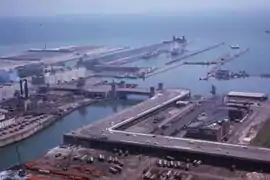 View of the site in 1963
View of the site in 1963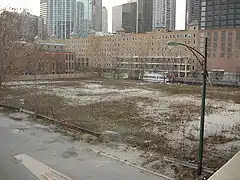 Months before construction on April 13, 2006
Months before construction on April 13, 2006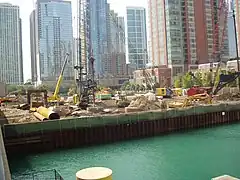 Bedrock being drilled on August 22, 2007
Bedrock being drilled on August 22, 2007 Closeup of base excavation January 12, 2008
Closeup of base excavation January 12, 2008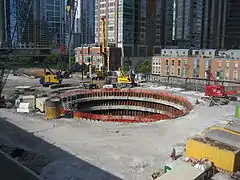 May 25, 2008
May 25, 2008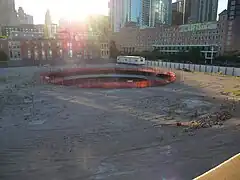 The site as of July 2, 2010
The site as of July 2, 2010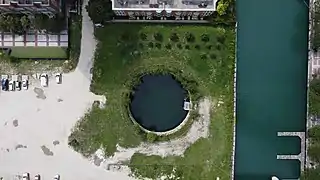 The Chicago Spire Hole as of July 30, 2021
The Chicago Spire Hole as of July 30, 2021
See also
References
Notes
- "The Chicago Spire, Chicago, Illinois, USA". SPG Media Limited. Retrieved July 18, 2009.
- Baeb, Eddie; Gallun, Alby (December 6, 2006). "Calatrava tower to drop spire". Crain's Chicago Business. Retrieved July 18, 2009.
- "Chicago Spire". SkyscraperPage.com. Retrieved August 3, 2007.
- "Calatrava's Latest Twist from Spire to Licorice Stick". Repeat. 2008. Retrieved July 18, 2009.
- "Shelbourne Development Awards Contract to Build Foundation of The Chicago Spire". Business Wire. June 26, 2007. Retrieved July 20, 2009.
- Corfman, Thomas; Kamin, Blair (July 26, 2005). "Tallest tower to twist rivals". Chicago Tribune. Retrieved July 18, 2009.
- McHugh, Michael (March 16, 2006). "Planning commission approves Fordham Spire". Crain's Chicago Business. Retrieved July 18, 2009.
- "Subscription Center". chicagobusiness.com. November 3, 2014. Retrieved January 17, 2015.
- Yue, Lorene (March 29, 2006). "City Council OKs Fordham Spire". Crain's Chicago Business. Retrieved July 18, 2009.
- "The Chicago Spire Achieves 30 Percent Sales". Shelbourne Development. April 6, 2008. Archived from the original on December 16, 2008.
- "Chicago Spire: Chicago, Illinois 60611, United States". Chicago Architecture.info. Retrieved July 19, 2009.
- "Tallest U.S. skyscraper proposed for Chicago". NBC News. Associated Press. July 25, 2005. Retrieved July 18, 2009.
- Stein, Alex. "The Chicago Spire" (PDF). Archived from the original (PDF) on June 20, 2010. Retrieved July 18, 2009.
- Bush, Haydn (March 22, 2006). "Calatrava Spire Gains Approval of Plan Commission". Natarus.com. Chicago Journal. Archived from the original on June 23, 2009. Retrieved July 18, 2009.
- Slevin, Peter (July 25, 2005). "Chicago Developer Wants to Erect Tower With a Twist". The Washington Post. Retrieved July 18, 2009.
- Marin, Matthew (July 20, 2006). "Irish Developer Will Build North America's Tallest Building in the Windy City". Multi-Housing News. Archived from the original on September 27, 2007. Retrieved July 19, 2009.
- Comerford, Mike (July 20, 2006). "New developer in works for site of Fordham Spire". Business. Daily Herald. p. 1.
- Roeder, David (July 20, 2006). "New twist in spire project". Chicago Sun-Times. p. 51.
- Jacobs, Scott (January 14, 2007). "Spinning politics with the Spire". Chicago Sun-Times. Archived from the original on January 18, 2007. Retrieved July 19, 2009.
- Kamin, Blair (December 21, 2006). "Controversial skyscraper plan gets new look". Chicago Tribune. Archived from the original on February 26, 2012. Retrieved July 18, 2009.
- Kamin, Blair (January 21, 2007). "New twists for lakefront skyscraper: An exclusive look at the latest Spire drawings". Chicago Tribune. Retrieved July 19, 2009.
- Beacker, Lynn (March 27, 2007). "Kamin unveils latest design for Calatrava's Chicago Spire". Repeat. Retrieved July 18, 2009.
- Kamin, Blair (March 8, 2007). "Final Chicago Spire plans set to be revealed". Chicago Tribune. Retrieved July 18, 2009.
- Diesenhouse, Susan (April 20, 2000). "Financial questions tower over Spire's political win". Chicago Tribune. Retrieved July 18, 2009.
- Baeb, Eddie (April 20, 2007). "Chicago Spire gets Plan Commission OK". Crain's Chicago Business. Retrieved July 18, 2009.
- Podmolik, Mary Ellen (September 30, 2008). "Beanie Baby magnate signs contract for Spire penthouse". Chicago Tribune. Retrieved July 18, 2009.
- Baeb, Eddie (June 30, 2008). "Spire developer adds a new twist". Crain's Chicago Business. Crain Communications Inc. Retrieved July 18, 2009.
- Baeb, Eddie (June 15, 2016). "Calatrava stops work on Spire, files lien". Crain's Chicago Business. Retrieved October 17, 2008.
- Roeder, David (December 26, 2008). "Spire mired in Irish bank crisis". Chicago Sun-Times. Archived from the original on December 26, 2008. Retrieved December 26, 2008.
- Hilliard, Mark (December 28, 2008). "Anglo Irish crisis leads to work halting on Chicago Spire". Sunday Tribune. Archived from the original on March 8, 2016. Retrieved December 10, 2009.
- Barrett, Joe (December 9, 2009). "Push to Finish Tallest Tower". The Wall Street Journal. Retrieved December 10, 2009.
- Corfman, Thomas A. (October 14, 2009). "Spire developer faces eviction from sales center site". Crain's Chicago Business. Retrieved December 10, 2009.
- Podmollik, Mary Ellen (November 30, 2009). "Spire developer Garret Kelleher to meet with leaders of AFL-CIO pension investment trusts". Chicago Tribune. Tribune Company. Archived from the original on December 2, 2009. Retrieved November 30, 2009.
- Corfman, Thomas A.; Baeb, Eddie (August 14, 2009). "Bank of America sues Spire developer". Crain's Chicago Business. Retrieved December 10, 2009.
- Roeder, David (December 9, 2009). "Spire inches closer to reality". Chicago Sun-Times. Archived from the original on December 13, 2009. Retrieved December 9, 2009.
- Baeb, Eddie (December 21, 2009). "Chicago Spire twists in wind as union funds pass on bailout loan". Crain's Chicago Business. Retrieved December 22, 2009.
- Boyer, Mark (November 17, 2010). "Facing Eviction Suit, Spire Developer Leaves Loop Offices : Chicago Spire Deathwatch". Curbed Chicago.
- "Irish Financial Crisis Helps Topple Planned Chicago Spire". The Wall Street Journal. November 12, 2010. Archived from the original on November 16, 2010.
- Kridel, Kris (October 11, 2010). "Foreclosure Suit Ends Dream Of Spire". CBS Chicago. Retrieved May 1, 2014.
- "Calatrava Dances onto a New Stage". Bloomberg. February 2, 2010. Archived from the original on February 13, 2011. Retrieved January 15, 2011.
- "Death knell for Chicago Spire as receiver appointed". The Boston Irish Emigrant. 2010. Retrieved January 15, 2011.
- "Spire developer loses control of site in foreclosure suit – 2 local firms have purchased delinquent property taxes". Chicago Tribune. December 7, 2010. Archived from the original on January 14, 2011. Retrieved January 19, 2011.
- Jonas, Ilaina (March 14, 2013). "Exclusive – For sale: Chicago land, once site for tallest condo tower". Reuters. Archived from the original on September 24, 2015. Retrieved October 27, 2014.
- "Condo Site Lives Again". The Wall Street Journal. May 14, 2013. Retrieved May 20, 2013.
- "What's Next for Santiago Calatrava's Troubled Chicago Spire?". Curbed Chicago. June 25, 2014. Retrieved January 17, 2015.
- "Chicago Spire developer gets funding, wants to resume project". Chicago Tribune. February 7, 2014. Archived from the original on February 7, 2014. Retrieved February 7, 2014.
- "Spire developer resolves debts, looks to start again". Chicago Tribune. March 11, 2014. Archived from the original on March 14, 2014. Retrieved March 14, 2014.
- "Related to Spire developer: Where's the deed?". November 3, 2014. Retrieved November 3, 2014.
- Quinlan, Ronald (March 5, 2018). "Garrett Kelleher pursuing Nama for $1.2bn over Chicago Spire project". Irish Independent. Retrieved May 15, 2018.
- "Related Midwest reportedly makes plans to develop Chicago Spire site". Crain's Chicago Business. September 6, 2016. Retrieved November 10, 2016.
- Two Waterfront Skyscrapers Planned For Deserted Spire Site. CBS Chicago. March 16, 2018. Accessed August 15, 2018.
- "SOM's "sister skyscrapers" for doomed Chicago Spire site halted". Dezeen. October 31, 2018. Retrieved November 1, 2018.
- Corfman, Thomas (July 19, 2006). "Carley's back finds familiar wall in bid to build Fordham Spire". Chicago Business. Crain Communications. Retrieved July 19, 2009.
- Bush, Haydn (March 22, 2006). "Calatrava Spire Gains Approval of Plan Commission". Natarus.com. Chicago Journal. Archived from the original on June 23, 2009. Retrieved July 19, 2009.|
- Herrmann, Andrew (September 18, 2006). "A DuSable park at last". Chicago Sun-Times. Archived from the original on October 13, 2007. Retrieved July 19, 2009.
- Yue, Lorene (March 26, 2007). "More twists in final plans for Chicago Spire". Chicago Business. Crain Communications. Retrieved July 19, 2009.
- Spielman, Fran (May 9, 2007). "City approves Chicago Spire design". Chicago Sun-Times. Archived from the original on May 13, 2007. Retrieved July 19, 2009.
- Palmer, Laurie. "3 Acres on the Lake: DuSable Park Proposal Project, Site Description and Context". Archived from the original on June 5, 2010. Retrieved July 19, 2009.
- Palmer, Laurie. "3 Acres on the Lake : Dusable Park, Chicago by Laurie Palmer". Archived from the original on September 8, 2007. Retrieved July 19, 2009.
- "Report: DuSable Park Site Near Navy Pier Nearly Clear Of Radioactive Soil". cbslocal.com. Retrieved January 17, 2015.
- Retrieved 24 June 2013, from http://www.chicagoparkdistrict.com/parks/Dusable-Park/
- Tzonis, Alexander (2004). Santiago Calatrava: The Complete Works. New York: Rizzoli.
- Stern, Andrew (March 29, 2009). "Global recession stalls skyscraper construction". Reuters. Retrieved July 19, 2009.
- Larson, George A.; Pridmore, Jay (2005). Chicago Architecture and Design: Revised and Expanded. New York: Harry N. Abrams.
- Matlock, Kelly (September 27, 2007). "Calatrava leads tour of Chicago Spire Sales Center". Archived from the original on January 17, 2008. Retrieved July 19, 2009.
- "House & Home". Financial Times. London. February 23, 2008. p. 3.
- Hampton, Tudor (March 27, 2006). "Chicago Builders Ride Next 'Supertall' Wave – Developers in the Windy City have their eyes set on luxury residences climbing over". Empire Projects. Archived from the original on June 24, 2009. Retrieved July 19, 2009.
- Baeb, Eddie (April 20, 2007). "Chicago Spire gets Plan Commission OK". Chicago Business. Crain Communications. Retrieved July 19, 2009.
- "The New Hancock Observatory". The Hancock Observatory. 2002. Archived from the original on August 29, 2007. Retrieved July 19, 2009.
- "Discover the All New Skydeck". Sears Tower Skydeck. Archived from the original on June 24, 2009. Retrieved July 19, 2009.
- Kamin, Blair (December 7, 2006). "Major redesign is latest twist in plan for spire". Chicago Tribune. Retrieved July 19, 2009.
- Salvadori, Mario (1982). Why Buildings Stand Up: The Strength of Architecture. New York: McGraw-Hill.
- "City council OKs plan for Chicago Spire building, would be nation's tallest". Chesterton Tribune. Associated Press. May 10, 2007. Archived from the original on June 23, 2009. Retrieved July 20, 2009.
- "Chicago Spire // USA // Santiago Calatrava". ArchiCentral. March 6, 2009. Archived from the original on August 16, 2009. Retrieved July 20, 2009.
- Baeb, Eddie (January 14, 2008). "Spire sales office opens today". Chicago Business. Crain Communications. Retrieved July 20, 2009.
- Roeder, David (September 19, 2008). "Business briefs: Economic upheaval causes delays in building of Spire". Chicago Sun-Times. p. 44.
- "Chicago Spire: Modest beginnings for a skyline icon". Chicago Tribune. September 10, 2008. Retrieved July 19, 2009.
- Sharma, Amol; Jennifer Saranow; Ilan Brat & Lauren Etter (October 1, 2008). "Businesses Pressure Congress on Bailout Plan". The Wall Street Journal. Dow Jones & Company. Retrieved July 20, 2009.
- Drake, Gary. "Chicago Spire Information". Archived from the original on April 30, 2009. Retrieved July 20, 2009.
- Giometti, Carl (September 10, 2008). "Holey Chicago! New Spire Renderings". Gapers Block. Retrieved July 20, 2009.
Further reading
- Keegan, E. (2005). Calatrava designing massive tower in Chicago. Architectural Record, 193, 29.
- McKeoug, T. (2006). Artist at work: Santiago Calatrava. Azure, 22, 56–61.
- Nobel, P. (2005). Onward and upward? Four years after 9/11 – at perhaps the peak of the real estate bubble – very tall has never been hotter. Metropolis, 25, 66–72.
- Pridmore, J., & Larson, G.A. (2005) Chicago Architecture and Design : Revised and expanded. Harry N. Abrams, Inc.: New York.
